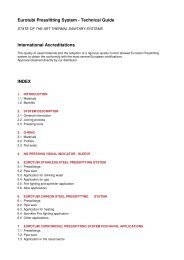Vis PDF - Damstahl
Vis PDF - Damstahl
Vis PDF - Damstahl
You also want an ePaper? Increase the reach of your titles
YUMPU automatically turns print PDFs into web optimized ePapers that Google loves.
Chapter 5: Ferritic, Stainless Steel<br />
A few years ago, the nickel-free, ferritic, stainless steel was regarded as a bit of a joke. A poor corrosion<br />
resistance combined with poor weldability and poor mechanical properties was not enough to<br />
compensate for the low price, and ferritic, stainless steels were only considered useful for making<br />
very simple, not-critical parts, such as cheap tea spoons.<br />
However, the unpredictable fluctuations of the nickel price during the last few years have changed<br />
this pattern markedly. From 2006 to the middle of 2007, the nickel price increased from 15,000 to<br />
55,000 $/ton, and shortly thereafter, it dropped steeply to 30-35,000. In December 2008, the price<br />
plummeted to 10,000 $/ton and in the time of writing (August 2009), the price has recovered to<br />
20,000 $/ton. Due to its (sometimes) very high price, nickel is the price determining element in normal,<br />
austenitic stainless steel, and most of the alloy surcharge for an EN 1.4301 steel (= AISI 304)<br />
happens to be nickel. For higher alloyed steel types, this pattern is even more evident. In short,<br />
nickel is a pricey and economically unstable element, and a lot could be gained if nickel was bypassed<br />
as alloying element. What if one could maintain the corrosion resistance without the nickel?<br />
Fortunately, that scenario is not entirely science-fiction. In most cases, the corrosion resistance<br />
depends on molybdenum (Mo) or chromium (Cr), while the main purpose of nickel (Ni) in stainless<br />
steel is to stabilize the ductile austenitic phase. Ni owes its presence to mechanical reasons rather<br />
than the corrosion resistance (Chapter 2), and by cutting down the Ni content, one gets a stainless<br />
steel possessing great corrosion resistance at a much lower cost. In short, that is the “secret” of the<br />
ferritic stainless steels: High Cr, perhaps Mo and little or none Ni.<br />
The table below shows the alloy composition of the most common ferritic steel types compared<br />
to the common austenitic ones. Please note that the Ni content of the five ferrites is close to zero,<br />
while the austenites contain at least 8 % Ni.<br />
EN Strukture % C % Cr % N % Mo Others AISI SS<br />
1.-<br />
4003 Ferrit ≤ 0,08 10,5-12,5 0,30-1,00 - N ≤ 0,030 410S -<br />
4016 Ferrit ≤ 0,03 16,0-18,0 - - - 430 2320<br />
4509 Ferrit ≤ 0,030 17,5-18,5 - - Ti 0,10-0,60; 441 -<br />
Nb 3xC+0,30 - 1,00<br />
4512 Ferrit ≤ 0,03 10,5-12,5 - - Ti 6x(C+N) - 0,65 409 -<br />
4521 Ferrit ≤ 0,025 17,0-20,0 - 1,80-2,50 N ≤ 0,030; 444 2326<br />
Ti 4(C+N)+0,15 - 0,80<br />
4301 Austenit ≤ 0,07 17,5-19,5 8,00-10,5 - N ≤ 0,11 304 2333<br />
4306 Austenit ≤ 0,030 18,0-20,0 10,0-12,0 - N ≤ 0,11 304L 2352<br />
4307 Austenit ≤ 0,030 17,5-19,5 8,00-10,5 - N ≤ 0,11 304L -<br />
4404 Austenit ≤ 0,07 16,5-18,5 10,0-13,0 2,00-2,50 N ≤ 0,11 316 2347<br />
4404 Austenit ≤ 0,030 16,5-18,5 10,0-13,0 2,00-2,50 N ≤ 0,11 316L 2348<br />
www.damstahl.com<br />
01.2013<br />
298
















